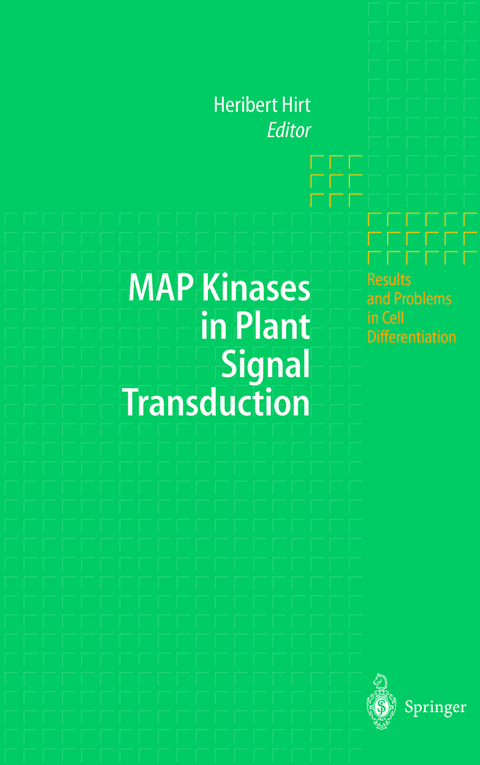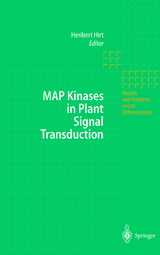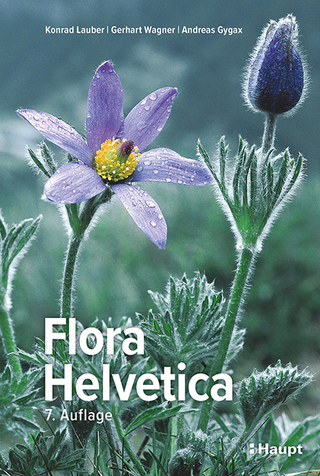MAP Kinases in Plant Signal Transduction
Springer Berlin (Verlag)
978-3-540-65625-8 (ISBN)
MAP Kinases in Plant Signal Transduction.- 1 MAPK Modules Form Basic Units of Eukaryotic Signal Transduction.- 2 Different MAPK Pathways Exist for Different Signals.- 3 What Are So Many Plant MAPK Genes For?.- 4 Arabidopsis: Emerging MAPK Modules.- 5 MAPKs and Stress Signaling.- 6 Cell Cycle.- 7 Auxin.- 8 Abscisic Acid and Giberellins.- 9 Ethylene.- 10 Concluding Remarks.- MAP Kinases in Plant Signal Transduction: How Many, and What For?.- 1 Introduction.- 2 The Structure of MAPKs.- 3 MAPKs in Yeast and Animals.- 4 Plant MAPK.- 5 Plant MAPKs Can Be Classified into Five Groups.- 6 PERK Groups: Towards a Functional Classification System of Plant MAPKs.- 7 How Many Are Out There? Plant ESTs with Similarities to MAPKs.- Reference.- MAP Kinase Cascades in Arabidopsis: Their Roles in Stress and Hormone Responses.- 1 Introduction.- 2 MAPK Cascades Involved in Stress Responses in Animals and Budding Yeast.- 3 Arabidopsis Homologs of Protein Kinases in MAPK Cascades.- 4 Transcriptional Control of the Putative Components of Arabidopsis MAPK Cascades in Response to Environmental Stresses.- 5 Activation of MAPK-Like Activity by Environmental Stresses in Arabidopsis thaliana.- 6 Analysis of Functional Interactions of the Components of MAPK Cascades in Arabidopsis Using the Yeast System.- 7 Putative Upstream Factors of MAPK Cascades in Arabidopsis.- Reference.- MAP Kinases in Pollen.- 1 Pollen Development and Germination.- 2 Signal Transduction in Pollen.- 3 Changes in Pollen Grains After Hydration.- 4 MAP Kinases in Pollen.- 5 The Response of MAP Kinase Signaling Pathways to Osmotic Stress.- 6 Specificity of the MAP Kinase Response.- Reference.- Mitogen-Activated Protein Kinases and Wound Stress.- 1 Introduction.- 2 Evidence for Activation of MAPK-Like Protein Kinases by Wounding.-3 Evidence for Activation of MAPKs by Wounding.- 4 Transcriptional Activation of MAPKs by Wounding.- 5 Systemic Activation of MAPKs by Wounding.- 6 What Is the Initial Wound Signal for Activation of MAPKs?.- 7 Studies of Function of MAPKs Using Transgenic Plants.- 8 Concluding Remarks.- Reference.- Pathogen-Induced MAP Kinases in Tobacco.- 1 Introduction.- 2 Salicylic Acid-Induced Protein Kinase (SIPK).- 3 MAP Kinases Activated by a Cell Wall-Derived Carbohydrate Elicitor and Purified Proteinaceous Elicitins from Phytophthora spp.- 4 Activation of SIPK by Bacterial Harpin.- 5 Activation of SIPK and WIPK by TMV.- 6 Activation of SIPK and WIPK by Avr9 from Cladosporium fulvum.- 7 Wounding and MAP Kinase Activation.- 8 General Discussion.- Reference.- Receptor-Mediated MAP Kinase Activation in Plant Defense.- 1 Introduction.- 2 Phytophthora sojae Elicitor-Induced Responses of Parsley Cells: A Model System for Plant-Pathogen Interaction.- 3 Pep-13 Elicitor Binds to a 100 kDa Plasma Membrane Receptor.- 4 Signal Transduction Events of Pep-13 Elicitor-Induced Defense Responses.- 5 Pep-13 Elicitor Induces Activation of a MAP Kinase.- 6 MAP Kinase Activation Occurs Through the Pea-13 Recentor.- 7 MAP Kinase Activation Is Dependent on Ion Fluxes.- 8 MAP Kinase Activation Is Independent of Oxidative Burst.- 9 Activation of MAP Kinase Is Correlated with Its Nuclear Translocation.- Reference.- Regulation of Cell Division and the Cytoskeleton by Mitogen-Activated Protein Kinases in Higher Plants.- 1 Regulation of the G1/S Transition: The Animal Paradigm.- 2 The Plant Players of G1 Control.- 3 Regulation of G2/M Transition: The Animal Paradigm.- 4 Plant Mitosis; Mechanically Different but the Regulation Might be the Same.- 5 Spatial Regulation of Cell Division and Growth are Dictatedby Plant Specific Cytoskeletal Structures.- Reference.- The MAP Kinase Cascade That Includes MAPKKK-Related Protein Kinase NPK1 Controls a Mitotic Process in Plant Cells.- 1 Isolation of the NPK1 cDNA.- 2 Identification of NPK1 as a MAPKKK.- 3 Structural Features of NPK1 and Its Arabidopsis Homologs, ANP1/2/3.- 4 Activity of ANP1 May be Regulated by Differential Splicing.- 5 Expression Pattern of the NPK1 Gene.- 6 Upstream and Downstream Factors of NPK1.- 7 Possible Function of NPK1.- Reference.- Mitogen-Activated Protein Kinase and Abscisic Acid Signal Transduction.- 1 Introduction: Facts and Speculation.- 2 Physiology of ABA.- 3 Signal Transduction Cascades of ABA.- 4 MAP Kinase Activation by ABA.- 5 The Importance of Protein Phosphatases for ABA Signalling.- 6 Conclusions.- References.- Signal Transduction of Ethylene Perception.- 1 Introduction.- 2 Detection of Phosphorylation Events in Ethylene Signal Transduction.- 3 A Survey of Putative Genetic and Molecular Components of the Ethylene Signal Pathway.- 4 Dynamics of Ethylene Perception and Signal Transduction.- Reference.
| Erscheint lt. Verlag | 13.8.1999 |
|---|---|
| Reihe/Serie | Results and Problems in Cell Differentiation |
| Zusatzinfo | X, 168 p. |
| Verlagsort | Berlin |
| Sprache | englisch |
| Maße | 155 x 235 mm |
| Gewicht | 396 g |
| Themenwelt | Naturwissenschaften ► Biologie ► Botanik |
| Naturwissenschaften ► Biologie ► Zellbiologie | |
| Schlagworte | Activation • Arabidopsis thaliana • Bioinformatics • cell cycle • cell division • Endoplasmatisches Reticulum • Ethylen • eukaryote • genes • MAP Kinase • MAP Kinasen • MAP Kinases • Pflanzenzelle • Physiology • plant hormones • Planzenhormone • Plasma membrane • Regulation • seed • signal transduction • Signalübertragung • Stress • transcription • Zellzyklus |
| ISBN-10 | 3-540-65625-1 / 3540656251 |
| ISBN-13 | 978-3-540-65625-8 / 9783540656258 |
| Zustand | Neuware |
| Haben Sie eine Frage zum Produkt? |
aus dem Bereich




